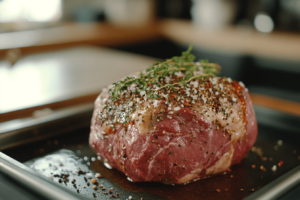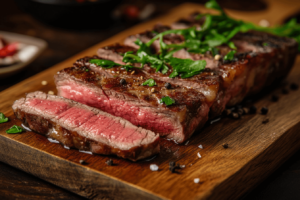Cooking a ribeye roast can feel intimidating, especially if you want that tender and juicy result. Yet, it does not have to be complicated. Understanding the right temperature is key. In this friendly guide, you will learn the best way to cook a ribeye roast so it stays moist and full of flavor. By the end, you will feel confident serving a show-stopping roast to family or friends.
Understanding the Ribeye Roast
A ribeye roast is a large cut that comes from the beef rib section. It is often called a prime rib or a standing rib roast. Its marbled fat gives it a rich taste and soft texture. This specific marbling melts during cooking, which keeps the roast tender.
When you choose a ribeye roast, you might see different labels like “bone-in” or “boneless.” Both are tasty, yet some people prefer bone-in for extra flavor. Others like the ease of a boneless roast. Still, both will do well if you pay close attention to temperature.
Moreover, the ribeye roast often commands a higher price because of its high quality. It makes for a festive centerpiece, especially around the holidays. Nevertheless, you can also enjoy it year-round for special occasions or Sunday suppers.
In any case, the secret to a savory ribeye roast lies in how well you manage its temperature. In this article, you will learn not just “What temperature should a ribeye roast be cooked at?” but also how to check doneness. Furthermore, you will see tips on resting time, seasoning, and more.
Why Temperature Matters
Temperature is critical for safety and flavor. Undercooked beef can hold harmful bacteria, while overcooked beef can turn dry. Hence, setting your oven to the right temperature ensures a safe and succulent meal. In addition, the cooking temperature influences how the fat melts.
Likewise, temperature also affects the rate of moisture loss. If it is too high, the roast can lose moisture quickly, resulting in a tough bite. Conversely, if it is too low, you may end up waiting forever for the roast to reach your desired doneness.
Additionally, the internal temperature of the roast when you remove it from the oven determines whether it is rare, medium rare, or well done. Ultimately, matching the cooking time to the ideal heat level is a balancing act.
Above all, controlling temperature helps you lock in taste. You can achieve a crusty exterior while preserving a rosy middle. That perfect blend of textures makes the ribeye roast a true feast.
Factors That Affect the Ideal Cooking Temperature
Many cooks ask, “What temperature should a ribeye roast be cooked at?” However, the answer can vary based on several things. First, the size of your roast matters. Larger cuts generally take longer and often benefit from lower, slower cooking methods.
Second, the presence or absence of a bone can change cooking times. Bone-in roasts sometimes take a bit longer because bones conduct heat in unique ways. Yet, many say bone-in roasts develop deeper flavor.
Third, personal preference plays a huge part. If you love a medium-rare roast, aim for a lower internal temperature. On the other hand, some people like their beef a bit more done. Therefore, final internal temperature goals will differ.
Finally, your equipment influences your roast. Different ovens may run hotter or cooler than their settings suggest. Consequently, an oven thermometer becomes a handy tool for checking actual heat levels.
Because of these factors, it helps to understand the standard guidelines, then adjust as needed. With that in mind, let’s dive deeper into the key question: “What temperature should a ribeye roast be cooked at?”
Best Temperature for Ribeye Roast
When making a ribeye roast, set your oven to a moderate heat level. Most chefs favor about 325°F (160°C). This temperature allows the roast to cook evenly without losing too much moisture. In fact, 325°F is often cited as an ideal balance for tender texture and good flavor development.
Yet, some recipes recommend 350°F (175°C). This slightly higher temperature can be useful if you are short on time or if your roast is smaller. It will cook faster, but be sure to keep a close eye on the internal temperature. Otherwise, you might overcook the beef.
In most cases, 325°F or 350°F are the prime choices for this cut of meat. You may also opt for a high-heat blast at the start (often 450°F for 15 minutes) followed by a drop to 325°F. This method helps create a crispy crust while the inside continues to cook at a gentle pace.
At this point, you might wonder: “Why not cook at 300°F or lower?” Low and slow approaches work for certain tough cuts, like brisket, but a ribeye roast is already tender. Cooking it too slowly can lead to dryness. Therefore, 325°F tends to be the sweet spot.
Similarly, you might ask: “What if I want to use 375°F or higher?” That can also work, but the risk of overshooting your desired doneness is higher. Plus, the crust might form too quickly, leaving the inside underdone. Transitioning from a short high-heat sear to a moderate temperature is often the most reliable approach.
Remember, these are guidelines. Ultimately, the safest bet is to monitor the internal temperature of the meat. That way, you get the exact level of pinkness or doneness you crave.
Ideal Internal Temperatures for Doneness
Now that you know the best cooking temperature range, it is also vital to understand internal temperatures. What temperature should a ribeye roast be cooked at internally? Each level of doneness aligns with a certain internal temp. Let us break it down:
- Rare (120–125°F / 49–52°C)
The center will be cool and deep red. This is ideal if you enjoy very tender, slightly cool meat. - Medium Rare (130–135°F / 54–57°C)
Many agree that medium-rare is perfect for a ribeye roast. The center is warm and pink, and the texture is melt-in-your-mouth. - Medium (140–145°F / 60–63°C)
The meat becomes more firm and has a light pink center. It still remains juicy, yet it loses some of that rosy hue. - Medium Well (150–155°F / 66–68°C)
At this stage, the meat is mostly brown with just a hint of pink in the center. It can become a bit drier. - Well Done (160°F+ / 71°C+)
This level leaves almost no pink. The roast is more firm and can be less juicy.
While some folks enjoy a well-done roast, many find that a ribeye roast shines best at medium rare or medium. That marbling stays luscious, and the texture stays tender.
Furthermore, remember to factor in carryover cooking. Once you pull the roast from the oven, its internal temperature may rise by about 5°F. Thus, it is wise to take the roast out a few degrees before it hits your target.
Techniques for Checking Doneness
It is not enough to set your oven to a certain temperature. You must also verify the internal temperature. A dependable way to do this is with a meat thermometer. Insert it into the thickest part of the roast, avoiding any bones.

There are two common types: instant-read thermometers and leave-in probe thermometers. Instant-read tools let you check the temp quickly when you open the oven. Leave-in versions stay in the meat throughout cooking, showing real-time temperature updates.
Meanwhile, some ovens come with built-in probes. If that is your case, you can watch the display as your roast cooks. Either way, measuring internal temperature is the most accurate method to achieve your desired level of doneness.
Also, pay attention to the color of the meat juices. If they run clear, your roast is likely fully cooked. If they have a pinkish hue, the roast still has some time to go. Nonetheless, color alone can be misleading, so a thermometer is more reliable.
Moreover, note how the roast feels when gently pressed. A rare or medium-rare roast feels softer, while a well-done roast feels more firm. With practice, you can also use this technique as a quick check. However, to avoid guesswork, rely on a thermometer.
Seasoning and Preparation Tips
While the proper temperature is crucial, do not forget the seasoning. Generously rub your ribeye roast with salt, pepper, and any preferred spices. Garlic powder or fresh minced garlic adds a nice kick. Sometimes, people include herbs like rosemary or thyme for an extra aromatic touch.
Before cooking, let the roast sit at room temperature for about 30 minutes to 1 hour. This helps it cook more evenly. Meanwhile, preheat your oven so it is at your desired setting when you are ready to place the roast inside.

In addition, consider using a roasting rack. Elevating the meat allows hot air to circulate, promoting even browning. If you do not have a special rack, a layer of sturdy vegetables like carrots, onions, or celery can act as a bed for the roast.
Furthermore, basting can keep the surface moist. However, opening the oven too often lets out heat. If you prefer a simple approach, skip the basting and rely on the roast’s natural fat to keep things juicy.
Additionally, a quick sear at a higher temperature for about 15 minutes at the start helps form a crust. Then, reducing the heat to 325°F ensures an even cook. If you choose 350°F, keep a closer watch as the roast will cook faster.
Resting the Roast
When the roast reaches your target internal temperature, take it out of the oven. Next, resist the urge to slice right away. Resting is vital. Let the roast sit for at least 15 to 20 minutes under a loose tent of foil. For bigger roasts, 30 minutes is even better.
This step allows the juices to redistribute. If you cut too soon, those juices escape onto the cutting board, leaving the meat less flavorful. Resting also makes carving easier because the roast firms up slightly, preventing it from shredding.
Moreover, remember that the roast’s temperature will rise a bit while it rests. Plan for that by removing it from the oven a few degrees earlier than your final target. You will get a succulent piece of beef in the end.
Carving Tips for a Picture-Perfect Presentation
After resting, place the roast on a stable cutting board. Use a sharp knife for clean slices. If your roast has bones, cut along the rib bones to remove them. Then, slice the boneless portion into thick slices.
Keep your slices about half an inch to an inch thick. This ensures that each serving captures the roast’s tenderness. Thicker cuts can give a more lavish feel, but thinner slices might help stretch the roast to feed more guests.

While cutting, try to maintain a steady motion. Avoid pressing down too hard, which can squeeze out juices. Instead, use long, gentle strokes.
Once carved, arrange slices on a warm platter. Spoon over any drippings or au jus for an extra boost of flavor. Your guests will love the enticing aroma and the sight of perfectly cooked beef.
Tips for Leftovers
In case you have leftovers, store them properly. Wrap slices in foil or place them in airtight containers. Then, refrigerate them as soon as possible. Leftover ribeye roast can last about three to four days in the fridge, yet always check for freshness.
Reheat slices gently to keep them from drying out. You can do this in a low oven, around 300°F, or in a skillet with a splash of broth. Cover the pan to trap steam, which helps retain moisture.
Additionally, consider repurposing leftovers. You can make savory sandwiches or use sliced roast in hearty salads. You could even dice the meat and add it to a stir-fry. This helps you enjoy the roast’s flavor in new ways.
Moreover, if you want to keep leftovers longer, freeze them. Wrap individual portions tightly. Then, place them in freezer-safe bags for up to two or three months. Thaw them in the fridge overnight before reheating.
Frequently Asked Questions
Should rib roast be 325 or 350?
Most people recommend cooking a rib roast at 325°F. This moderate temperature helps ensure even cooking while maintaining juiciness. However, 350°F is also an option if you want a faster cook time, although it increases the risk of overcooking.
What temperature should ribeye be cooked at?
Ribeye is often best when cooked to medium rare or medium. Aim for an internal temperature of about 130–135°F for medium rare, or around 140–145°F for medium. You can cook it at 325°F or 350°F in the oven until it reaches your desired level of doneness.
Do you cook roast beef at 325 or 350?
Both 325°F and 350°F work for roast beef. Many cooks favor 325°F for a slower, even cook. Others choose 350°F for a slightly quicker result. In either case, use a meat thermometer to be sure you reach the perfect internal temperature.
What temperature should ribeye roast meat be?
You should remove your ribeye roast from the oven when it hits your target internal temperature. For example, if you want medium rare, aim for 130–135°F. Keep in mind that it may rise a few degrees while resting.
Conclusion
Choosing the right temperature for a ribeye roast does not have to be daunting. In most cases, 325°F offers a stable, slower cook that delivers a tender inside and a flavorful crust. Meanwhile, 350°F speeds things up a bit if you have a smaller roast or are short on time. Regardless, watch your internal temperature for the best results.
With a reliable thermometer, a good rest period, and proper carving, you can serve an impressive roast. The secret lies in balancing heat, time, and patience. By applying the tips shared here, you will create a ribeye roast that delights everyone at the table.
Enjoy your next feast, and remember that practice makes perfect. Each roast you cook will refine your skill. Soon, you will have the confidence to try new rubs, experiment with different herbs, and even adjust cooking times for various sized roasts. Most of all, savor the moment when you slice into that juicy, perfectly done ribeye roast.

